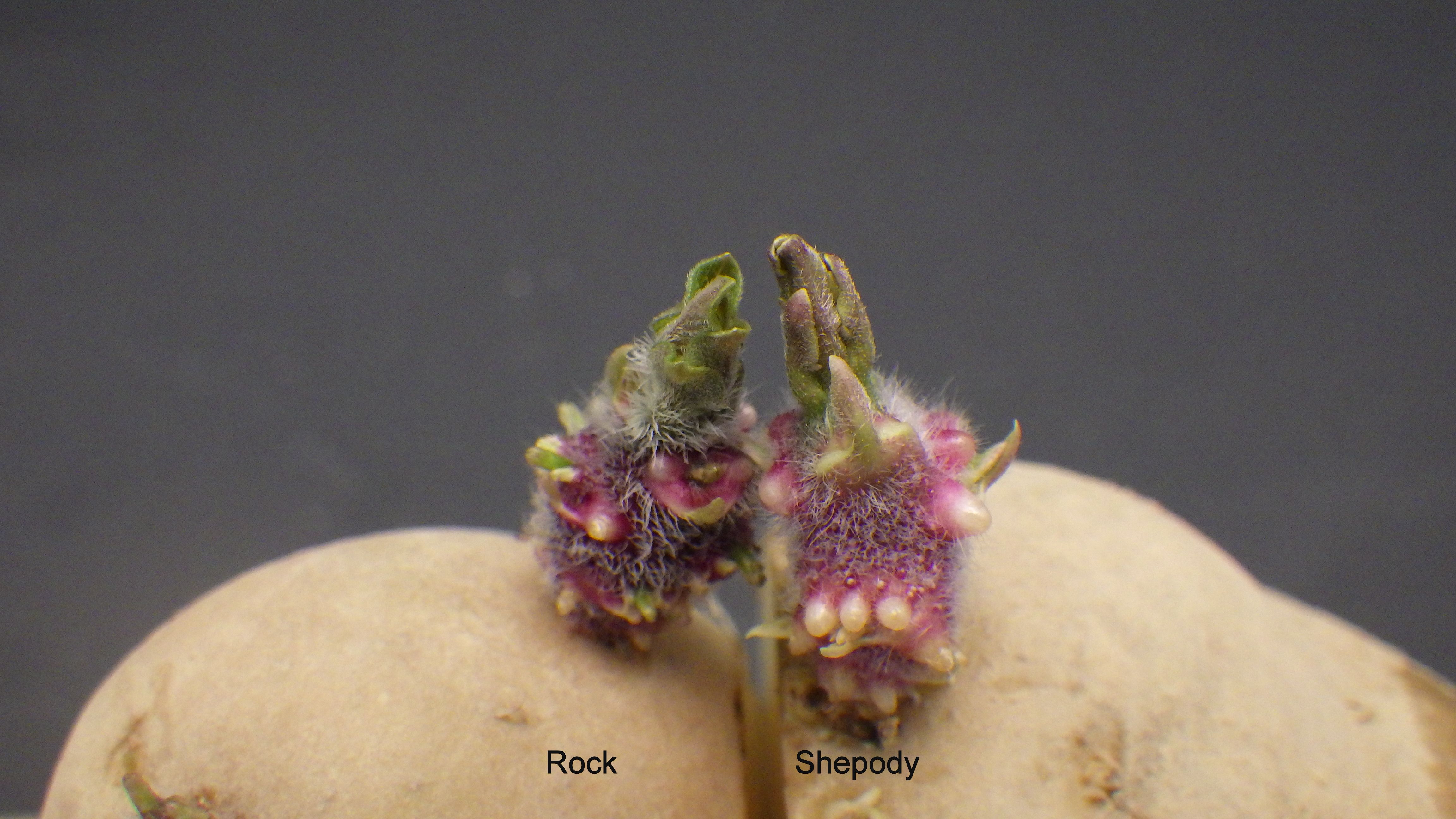Rock
| Denomination: | 'Rock' |
|---|---|
| Botanical Name: | Solanum tuberosum |
| Applicant/Holder: |
C. Meijer B.V. Stationsweg 18a, 4416 PJ Kruiningen Postbus 1, 4416 AG Kruiningen Netherlands |
| Breeder: |
J.P.M. Muijsers, C. Meijer B.V., Kruiningen, Netherlands |
| Agent in Canada: |
Global Agri Services Inc. 376 New Maryland Highway New Maryland, New Brunswick E3C 1E5 Canada Tel: 506-462-9493 |
| Application Date: | 2016-04-01 |
| Provisional Protection:: | 2016-04-01 |
| Application Number: | 16-8860 |
| Grant of Rights Date: | 2019-01-10 |
| Certificate Number: | 5891 |
| Grant of Rights Termination Date: | 2039-01-10 |
Variety Description
Variety used for comparison: 'Shepody'
Summary: The tip of the lightsprout of 'Rock' has a weak intensity of anthocyanin colouration and dense pubescence whereas the tip of the lightsprout of 'Shepody' has medium to strong intensity of anthocyanin colouration and sparse pubescence. The plant foliage structure of 'Rock' is an intermediate type (foliage half open, stems partly visible) whereas that of 'Shepody' is a leaf type (foliage closed, stems not, or hardly visible). The plant of 'Rock' is taller than that of 'Shepody'. The frequency of inflorescences per plant is medium on 'Rock' whereas the frequency is high on 'Shepody'. The extent of the anthocyanin colouration on the inner side of the corolla is absent or very low for 'Rock' whereas it is medium for 'Shepody'. The intensity of the anthocyanin colouration on the inner side of the corolla is absent or very weak for 'Rock' whereas it is medium for 'Shepody'. The tuber flesh of 'Rock' is a light yellow colour whereas it is white for 'Shepody.
Description:
LIGHTSPROUT: medium size, ovoid shape, root tips few in numbers, short lateral shoots
LIGHTSPROUT BASE: very strong intensity of anthocyanin colouration, absent or low to medium proportion of blue in anthocyanin colouration, medium to dense pubescence
LIGHTSPROUT TIP: small size in relation to base, closed habit, weak intensity of anthocyanin colouration, dense pubescence
PLANT: foliage structure is intermediate type where foliage is open and stems are not clearly visible, upright to semi-upright growth habit, mid-season to late maturity
STEM: low extent of anthocyanin colouration halfway up stem
LEAF: medium to large outline, openness is intermediate between closed and open, weak presence of secondary leaflets, medium to dark green on upper side, absent or very low extent and absent or very weak intensity of anthocyanin colouration on midrib of upper side, absent or very low frequency of coalescence of terminal and lateral leaflets
SECOND PAIR OF LATERAL LEAFLETS: large, leaflet is narrower than long
LEAFLET: absent to very weak waviness of margin, medium depth of veins, medium glossiness of upper side, pubescence present on blade at apical rosette
INFLORESCENCE: medium frequency per plant, small to medium size
PEDUNCLE: low extent of anthocyanin colouration
FLOWER BUD: medium to high extent of anthocyanin colouration
COROLLA: medium size, absent or very low extent and absent or very weak intensity of anthocyanin colouration on inner side, absent or low proportion of blue in anthocyanin colouration on inner side
TUBER: oval to long oval shape, light yellow flesh
TUBER EYE: shallow depth, yellow at base
TUBER SKIN: yellow, develops very weak to weak intensity of anthocyanin colouration in reaction to light
Origin & Breeding History: 'Rock' (experimental designation 'CMK2004-075-048') originated from a cross between the variety 'Ramos', as the female parent, and the selection 'CMK 1993-042-005', as the male parent, conducted in 2003 in Rillard, Netherlands. From the resulting progeny, 'Rock' was selected in 2005 based on its adaptation ability, yield, maturity, grading, depthness of eyes, general impression, disease resistance and cooking quality.
Tests & Trials: The comparative test and trial for 'Rock' was conducted by Global Agri Services Inc. during the growing season of 2017 in Drummond, New Brunswick. The trial consisted of a single, 21.2 metre long row containing 70 plants spaced 0.3 metres apart for each variety. The distance between rows within the trial was 0.9 metres. The observations and measurements were taken from 10 plants, or 10 parts of plants, of each variety. The mean difference was significant at the 5% probability level based on a paired Student's t-test.
Comparison table for 'Rock' with reference variety 'Shepody'
Plant height (cm)
| 'Rock' | 'Shepody' | |
|---|---|---|
| mean | 66.6 | 61.3 |
| std. deviation | 2.6 | 3.0 |
Click on image for larger view

Potato: 'Rock' (left) with reference variety 'Shepody' (right)
- Date modified: